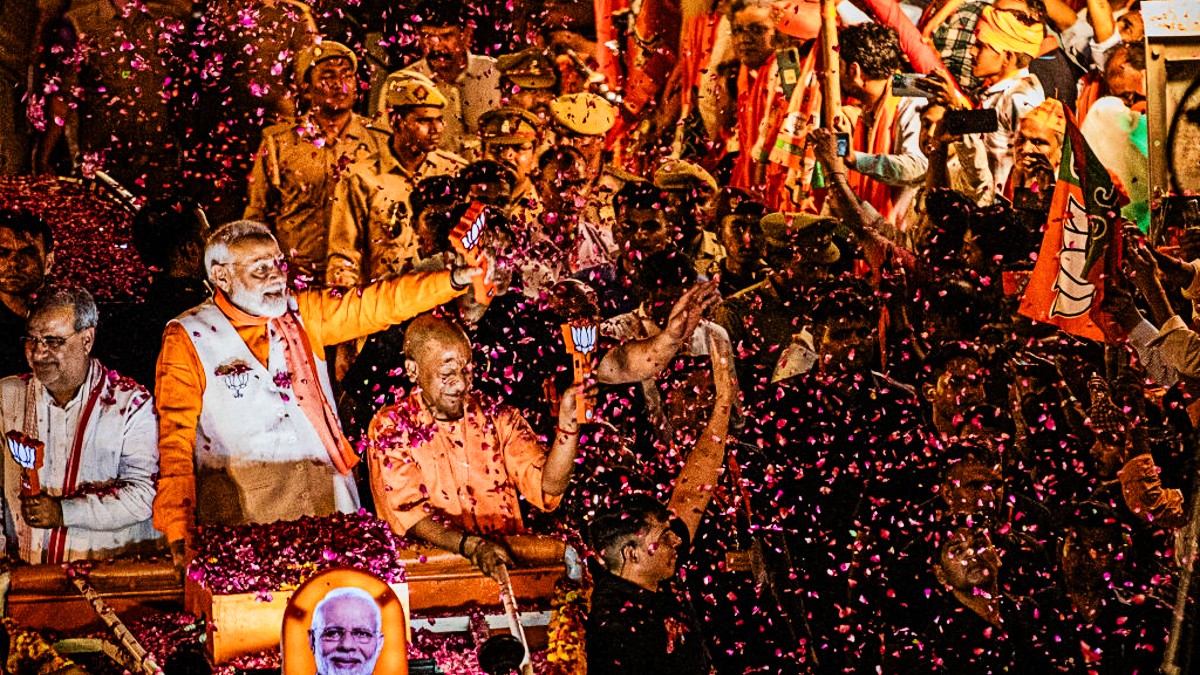The largest democratic exercise in the world is happening in India, with close to 1 billion people going to the polls between 19th of April to 1 June.
Right now, Indian Prime Minister Narendra Modi’s fantabulous roadshow is in Varanasi, India’s Hindu heartland – a symbolic stronghold for Modi’s Bharatiya Janata (BJP) Party.
The 2024 general election has over 969 million registered voters, more than the combined population of Australia, the EU, US, and Russia.
The election process, lasting 82 days, will be held in seven phases, covering the entire country from the Himalayas to the Indian Ocean, with an estimated 15 million polling staff and security personnel.
The results will be announced on the 4th of June.
The election is expected to cost US$14.4 billion, making it the world’s most expensive, with political parties and candidates spending lavishly to woo voters.
If one was to go by economic growth figures alone, the Modi government’s performance has been impressive, says Professor Kunal Sen, director at the World Institute for Development Economics Research, United Nations University.
When Modi came to power in 2014, economic growth was sluggish, after some headline corruption scandals led to a loss of investor confidence.
“But between 2014 and 2022, India’s gross domestic product (GDP) per capita (a measure of income per head) rose from US$5,000 (£4,000) to over US$7,000 – an increase of roughly 40% in eight years,” according to Prof Sen.
Mugunthan Siva, managing director at India Avenue Investment Management told Stockhead India has deployed new tech to ensure a secure and transparent vote – and whilst the outcome is expected to be a bit of foregone conclusion, with the BJP expected to take up its 3rd consecutive term – as is the case in any democracy, Mugunthan says a majority will matter.
Modi: The man, the landslide
Photo by Ritesh Shukla/Getty Images
SH: Why is Modi and the BJP likely to romp this one in?
MS: In 2019 the BJP swept to a landslide victory, capturing 303 seats out of the Lok Sabha’s 542 seats (this is prior to any allied parties being included). This time the BJP is targeting an ambitious 400 seats!
Its track record over the last 10 years has shown achievement of some broad targets which relate to economic, regulatory and market reforms. Over this period India has effectively financialised (opening of 500m bank accounts), formalised (increasingly shifting from unorganised to organised business) and digitised (digital transactions in India lead the world – in 2023 with 129bn digital transactions, India accounted close to 50% of the global real-time payments).
MS: This has led to a greater transfer of economic success to a broader population, less slippage, and a reduced cost of doing business. Particularly since the pandemic, India’s trajectory has been different to the developed world. GDP growth has been robust (8.4% recorded y-o-y in December 2023), infrastructure has been built (airports, seaports, national highways and roads, railway and installed renewable energy capacity.
According to the International Monetary Fund, India’s economy is projected to grow at a rate of 6.5% in this year. That’s still higher than China’s projected growth of 4.6%, and exceeds that of any other large economy.
Bank accounts linked to a National ID card (Aadhaar Card) and a mobile phone has helped to reduce slippage of direct subsidies to the poor. Public health and hygiene have been a focus, with infant mortality falling and life expectancy rising. These factors are rapidly reducing poverty in India.
SH: You’ve highlighted Government spending on Infrastructure as one of the major thematics to emerge in the run up, can you walk us through that?
MS: The National Infrastructure pipeline was set up for FY19-25 and was the first of its kind. The focus was to increase spending on India’s infrastructure and further investment into the sector.
To achieve India’s goal of being a US$5 trillion economy by 2025, India’s infrastructure must improve. The success of India’s manufacturing sector and to meet the needs of growing urbanisation and a focus on services as the backbone of the economy will require increasing infrastructure. The plan is for over 10,000 projects, costing US$1.8 trillion across 56 sub-sectors.
MS: For example, India’s Road Network is now the second largest in the world, spanning 6.7m kilometres and includes national and state highways, district, and rural roads. Roads are being built at a pace of 27km per day!
Since Modi took office in 2014, 90,000km of National Highways have been built, which is almost double that of previous decade. This is set to grow by a further 8-10% in FY25 according to ICRA, India’s ratings arm of Fitch.
SH: Okay. Getting down to brass tacks, when investing in India’s equity markets – how will you be playing India’s infrastructure story?
Cement
“India is the world’s second largest cement producer with over 380 million metric tons, which is close to 8% of global installed capacity. The country has high quantity and quality of limestone deposits.”
Mugunthan says growth is being driven by infrastructure and real estate development. Foreign investment into the industry has amounted to US$5.5bn since the turn of the century.
Orient (CTM:BSE) YTD
“Orient Cement, based in Hyderabad, is part of the CK Birla Group, which is a diversified Indian conglomerate group with over A$2.4bn in revenues across its companies,” Mugunthan told Stockhead.
He says Orient has market presence across 11 states in South and Central India and a market cap of A$790m, generating a profit of A$31m.
“Given the attractive growth profile of the industry and Orient’s heartland in the South of India, being the most productive, it is likely that the company will benefit from economic growth, a quality product, and reasonable valuations at 2.5xBV compared to the larger players (4-5xBV).”
Cables & Wiring
Given India’s demographics and focus on infrastructure, Mugunthan says the next decade at least is set to see significant growth in cables and wiring, particularly now that the country is largely fully electrified.
“This is being led by the government’s focus on providing power to all and gradual pickup from the housing market. Increasing demand will come from renewable power generation, data centres/IT facilities, railways and 5G rollout.
“The rate of market growth for cable and wire companies is set to average 4% going forward.”
Mugunthan says Polycab Industries is a company operating in the electrical industry and it’s been one of the fastest growing companies in the sector.
I say you can learn a lot from a TV commercial.
The company manufactures and distributes wires and cables as well as electric fans, LED lighting and luminaires, switches and switchgear, solar products, and conduits & accessories.
The Wire and Cables segment includes the manufacture and sale of electric wires and cables. The FMEG segment relates to the electric consumer durable business comprises of business covering electric wiring accessories and electric appliances.
Polycab Industries (POLYCAB: NSE/BSE) YTD
Polycab operates in 43 countries now and is a play on India’s real estate, construction, and infrastructure industries.
“It’s grown revenues by 18% p.a. over the last 5 years, with EBIT margins that have doubled over the last 10 years. Polycab has continued to win market share in the expanding industry as a market leader. Profits have grown therefore at a pace of 29% p.a. over the last 5 years.
“Polycab trades on a P/E multiple of over 50x but is underpinned by strong fundamental tailwinds, both at macro and micro level.”
Construction
Mugunthan says the scope of India’s construction sector is hard to grasp – the latest guesses are up around US$640bn.
“This is being led by Infrastructure needs of India in activities that might involve:
“Modernising and building new ports, improving port connectivity, boosting port-linked industrialisation, and building up coastal communities….A new highway umbrella program that focuses on improving the efficiency of freight and passenger movement across the country.
“A plan for expressways is being implemented, allowing for faster transit. The road sector experienced enormous growth as highway construction continued at a fast pace and the approval and completion of several projects occurred.”
He says that the Modi Government approved the development of 21 greenfield airports in 2022 and have a further 21 to be built over the next few years.
While, in the next four to five years, the Airports Authority of India (AAI) plans to create new airports as well as expand and upgrade many existing airports at a cost of US$338m.
Mugunthan likes the Nagarjuna Construction Company
Nagarjuna is focused on construction and infrastructure building.
“The Group has a presence across nine cities in India and its activities include buildings, transportation, water and environment, irrigation, electrification, mining, and railways. Profit growth over the last 5 years has annualised at 15% given increasing projects and economic activity.”
Nagarjuna Construction Company (NCC:NSE/BSE)
“Given the focus of the government on Infrastructure, the companies that have benefitted the most are those in the value chain, which are benefitting from increasing order books (today stands at A$9bn).”
At 24x P/E and a market cap of A$2.4bn, Mugunthan says the company has an attractive profile relative to its growth.
“Valuation is on the side of companies benefitting from the next cycle and perhaps what was expensive post the last cycle (Financials and Consumption), will give way to more cyclically aligned businesses which will benefit from economic activity and a continued agenda by the Government and the private investment.”
The views, information, or opinions expressed in the interviews in this article are solely those of the interviewee and do not represent the views of Stockhead.
Stockhead does not provide, endorse or otherwise assume responsibility for any financial product advice contained in this article.
The post India is betting on Narendra Modi. You can too. appeared first on Stockhead.






















